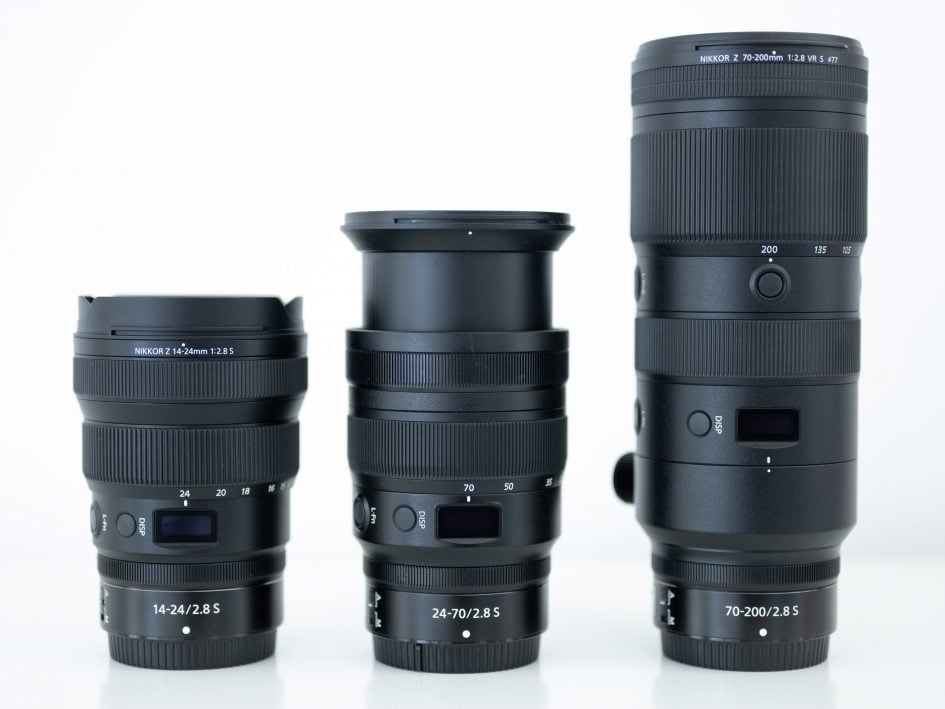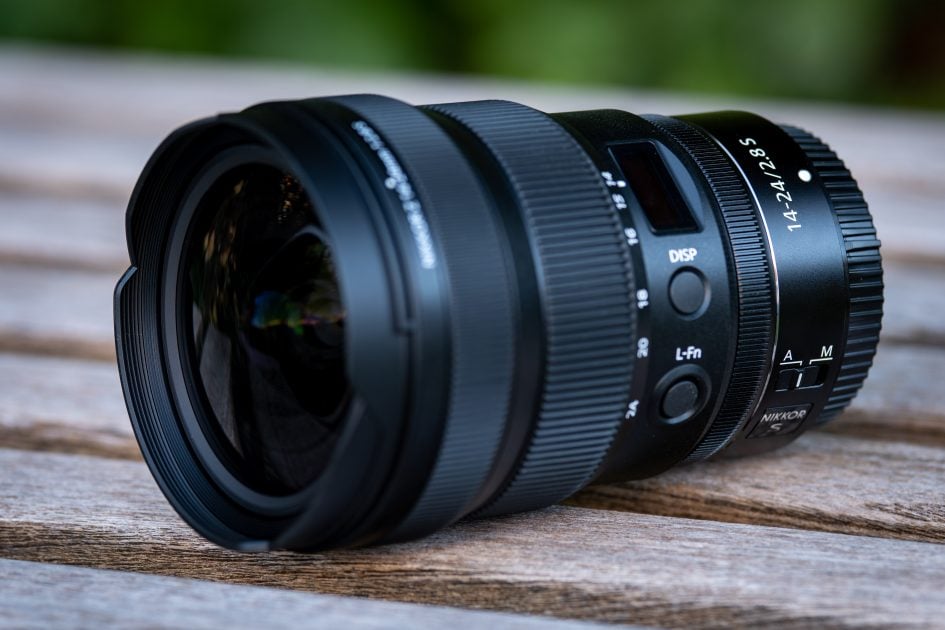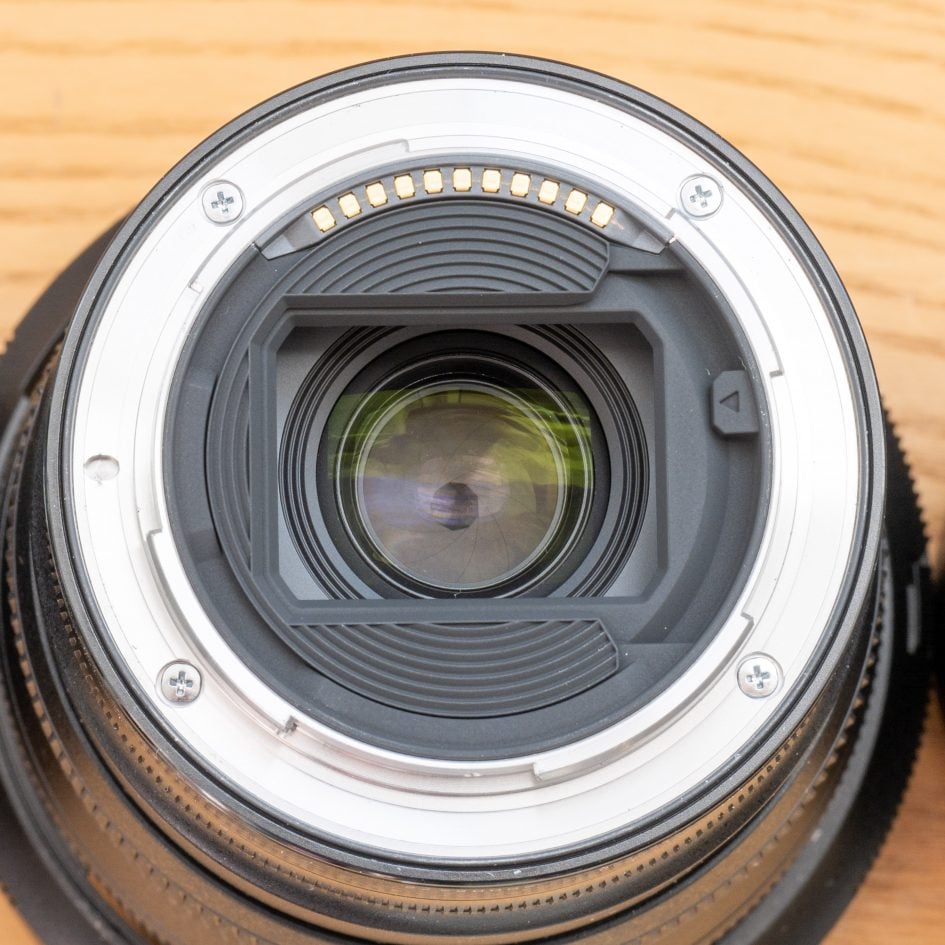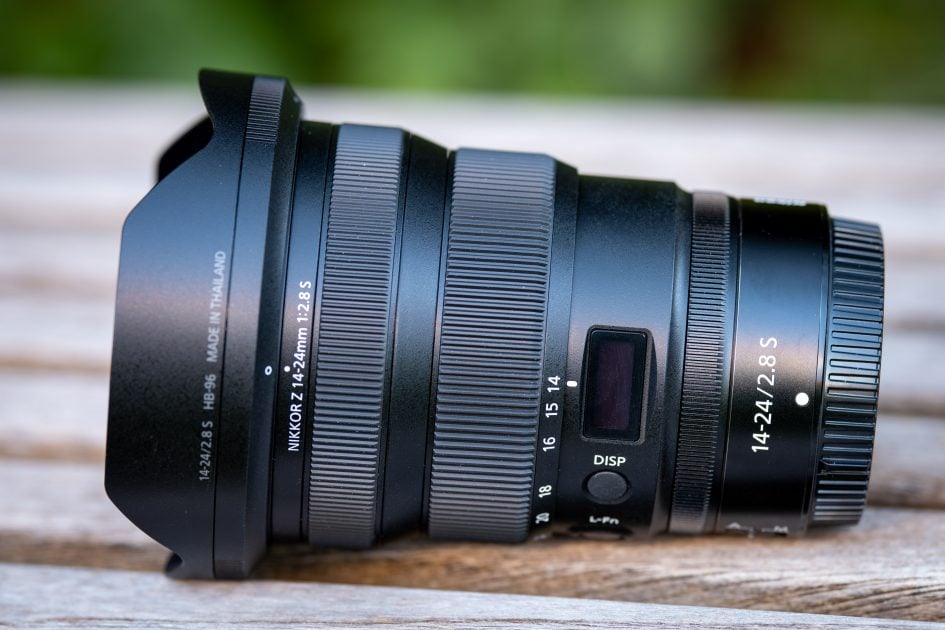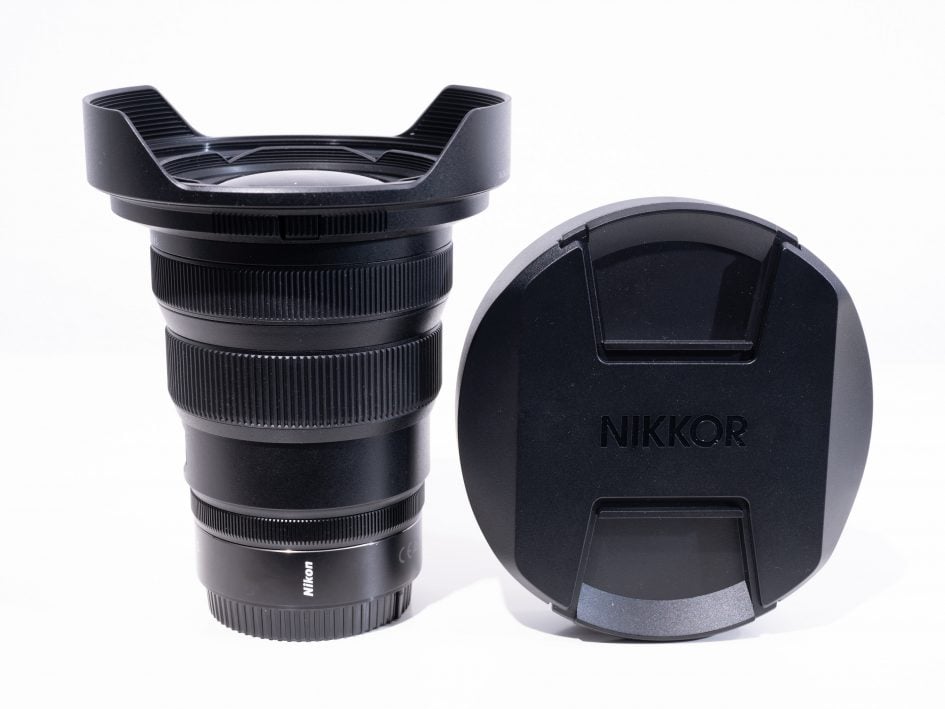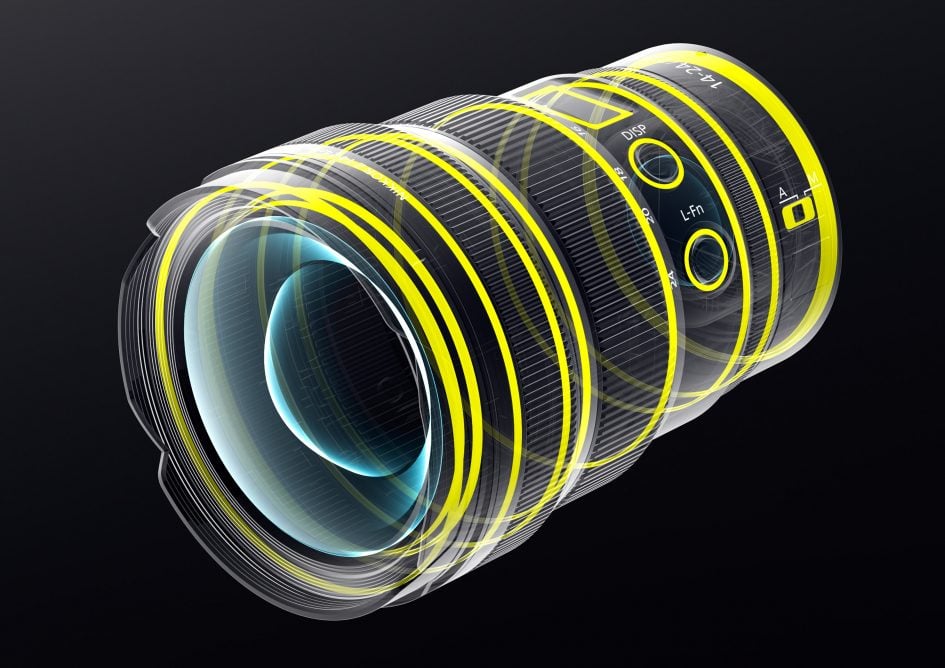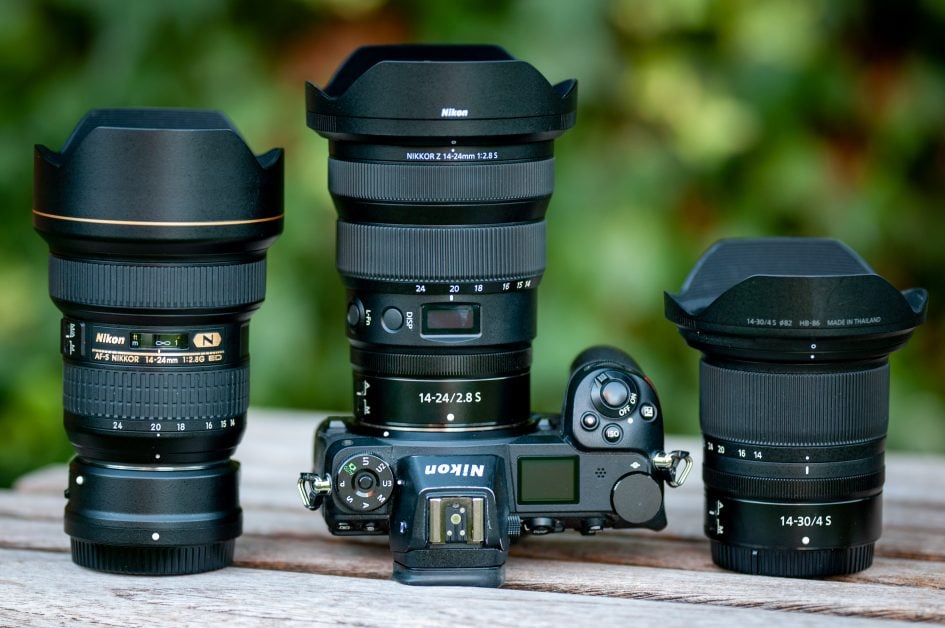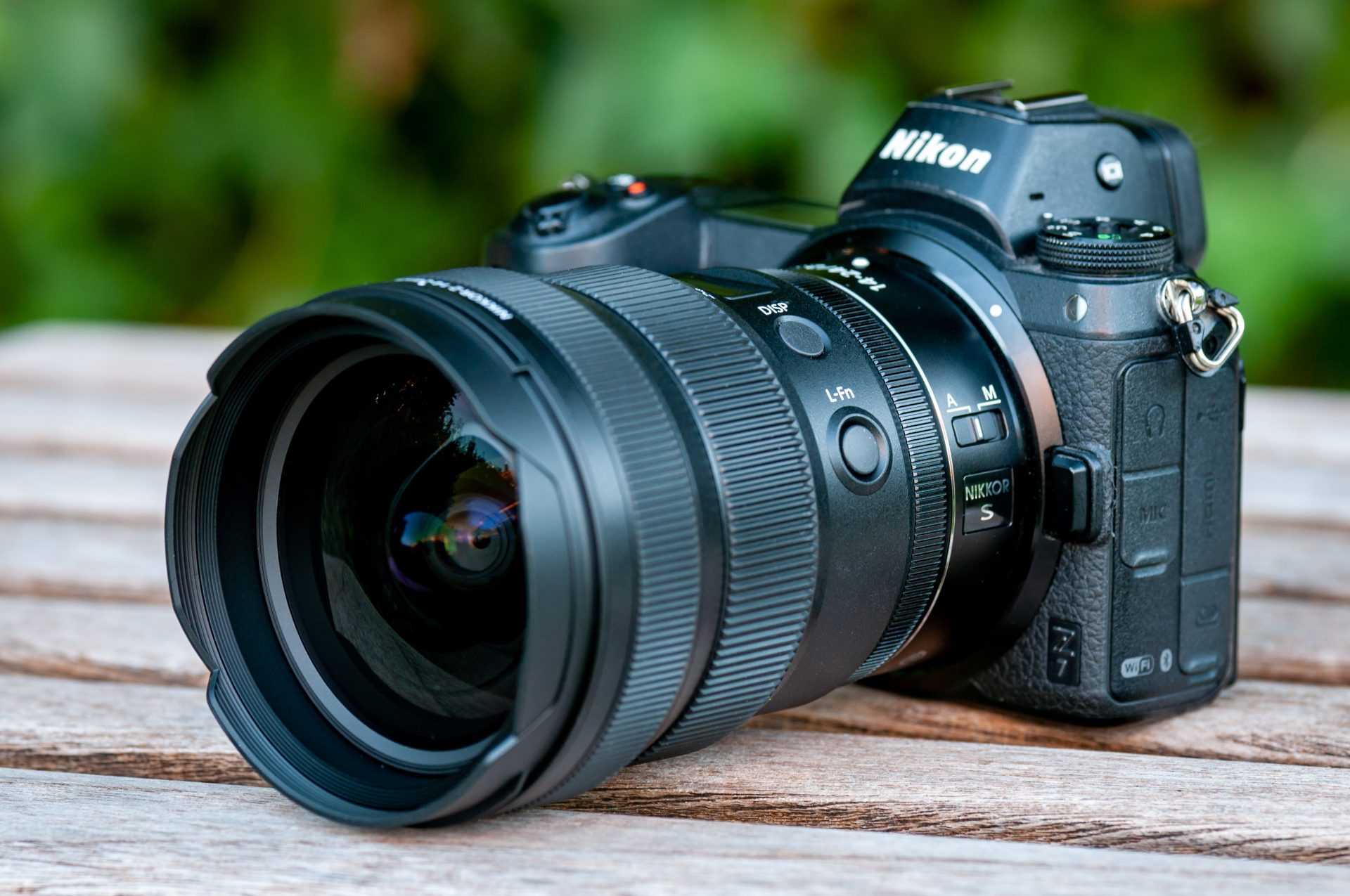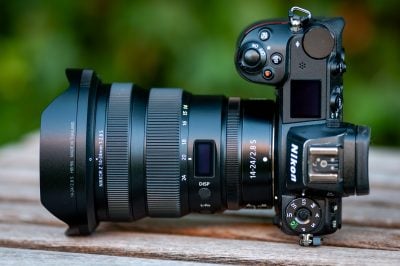Nikon Z 14-24mm f2.8 S review
-
-
Written by Thomas
Intro
The Nikon Z 14-24mm f2.8 S is a professional ultra-wide angle zoom designed for Nikon’s full-frame Z-series mirrorless cameras. Announced in September 2020, it’s the third native zoom with a fast f2.8 focal ratio and together with Nikon’s Z 24-70mm f2.8 S and Z 14-24mm f2.8 S completes the trinity of professional f2.8 zoom lenses for Nikon’s Z system.
The Z 14-24mm f2.8 S is a unique lens: it’s the only full-frame zoom lens starting at 14mm focal length with a large f2.8 focal ratio which allows to use standard filters albeit of a huge 112mm diameter – or you can use gel-filters in the rear holder. This is different from its F-mount predecessor, the AF-S 14-24mm f2.8G, which had such a bulbous front element with built-in lens hood that one had to resort to a third party solution which attaches to the front-end of the barrel. Other features also put the new Z 14-24mm f2.8 S ahead of its F-mount sibling: It has a customizable function ring which can be assigned to operate the aperture or the ISO or exposure compensation and it features the nifty OLED display which Nikon introduced with its Z 24-70mm f2.8 S lens. It can indicate focal length, aperture, or focusing distance and depth-of-field. And the new Z-Nikkor also has an additional button which can be assigned different functions e.g. AE/AF-lock.
The Nikon Z 14-24mm f2.8 S is listed at 2630 EUR (incl. 16% VAT) / 2400 USD / 2500 GBP. In my review I’ve compared the new lens and its F-mount predecessor plus the Nikon Z 14-30mm f4.0 S. PS – if you’re interested in the other Z zoom lenses in Nikon’s line-up check out our in-depth reviews: Nikon Z 14-30mm f4.0 S review / Nikon Z 24-70mm f2.8 S review / Nikon Z 24-70mm f4 S review / Nikon Z 24-200mm f4-6.3 VR review / Nikon Z 70-200 f2.8 VR S review.
Facts from the catalog
Let’s compare the Nikon Z 14-24mm f2.8 S to the Nikon AF-S 14-24mm f2.8G (“F-Nikkor” for short) and the Z 14-30mm f4.0 S. As usual I’ve rated the features with a [+] (or [++]), when it’s better than average or even state of the art, a [0] if it’s standard or just average, and [-] if there’s a disadvantage.
Size (diameter x length): At 89 x 125mm (3.5 x 4.9in.) without lens hood the new Z-Nikkor is slightly shorter and slimmer than the F-Nikkor at 98 x 132mm including lens hood. Add another 30.5mm for the FTZ adapter when using the F-Nikkor on a Nikon Z body. Zooming does not change the length of both lenses. The Z 14-30mm f4.0 is 89 x 85mm + 25mm for the lens hood. But the short length of 85mm is reached only in its collapsed state which shaves 29mm off the maximum operating length of 114mm at 14mm focal length. The following images show the section of each lens at a comparable scale. [0]
Weight: 650g (23 oz.) plus 35g lens hood. This is comparatively lightweight especially against the F-Nikkor which is 1000g including lens hood – plus another 133g for the FTZ adapter to use it on a Nikon Z body. But even the latest ultra-wide angle f2.8 zooms from Sony and Sigma for E-mount are clearly heavier at 847g and 795g respectively. The Z 14-30mm f4.0 S is lighter at 479g + 18g lens hood but then it is only f4.0. [+]
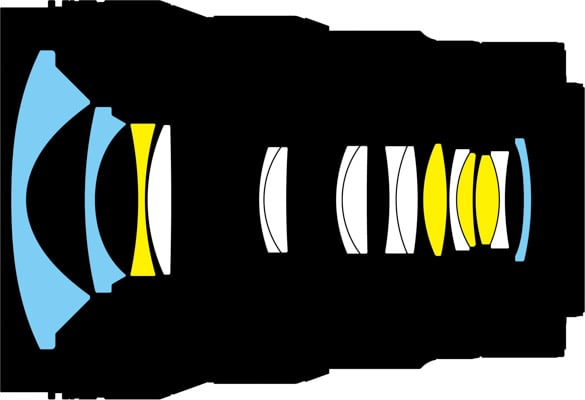
Above: Nikon Z 14-24mm f2.8 S
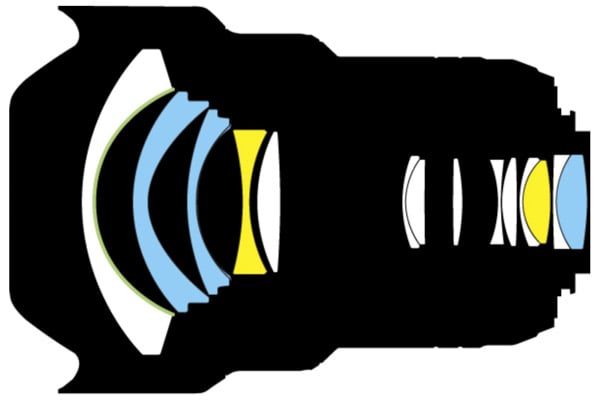
Above: Nikon AF-S 14-24mm f2.8G
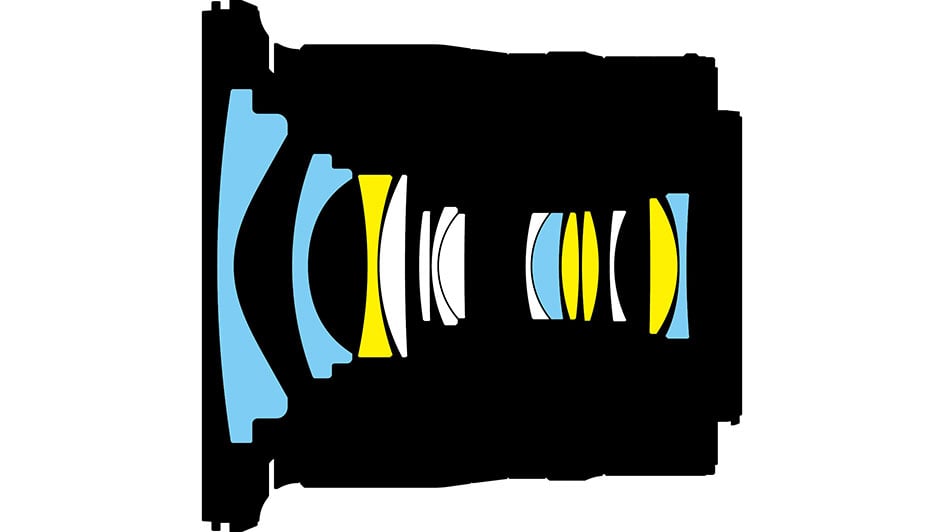
Above: Nikon Z 14-30mm f4 S
Optics: The Nikon Z 14-24mm f2.8 S has 16 elements in 11 groups including 4 special dispersion elements and 3 aspherical elements. This is similar to the F-Nikkor (14 elements in 11 groups) but with a higher number of special elements. To reduce reflections causing flare, glare and ghosting both Z-Nikkors and the F-Nikkor employ Nikon’s Nano-coating but only the Z 14-24mm f2.8 S profits from the new “ARNEO” anti-reflective coating. Both Z-Nikkors also have fluorine-coating on the front element to repel water, dust, and dirt and make cleaning easier. [+]
Closest focus distance is 0.24m (0.92ft.) at 24mm focal length with a magnification of 1:5.8 which is not much. This results in a working distance of around 10cm. The F-Nikkor is similar with a magnification of 1:6.2 at 0.27m object distance, the Z 14-30mm f4.0 S goes to 1:5.1 from 0.25m. A magnification of 1:10 is reached at 0.35m focus distance similar to the F-Nikkor. The Z 14-30mm f4.0 S achieves 1:10 at 0.41m due to its longer focal length. [0]
Filter-thread: The new Z Nikkor needs huge 112mm filters which can be mounted in one of the two lens hoods that come with the lens. 112mm filters are pretty expensive but you can also use gel filters in a rear filter holder (see image below). Keep in mind though that gels cannot be rotated which precludes the use of polarizers. For the F-Nikkor you’d need a third party solution which attaches to the front-end of the barrel, such as the Lee SW150 system. The Z 14-30mm f4.0 S uses standard 82mm filters. [0]
Image stabilization: The new lens offers no optical stabilization just like the F-Nikkor and Z 14-30mm f4.0 S. But the Nikon Z bodies provide built-in sensor-shift stabilization over 5 axis – plus an optional electronic stabilization option in video mode. [0]
Auto focus: Yes with built-in AF drive. Manual-focus override is by simply turning the dedicated focus ring at the front of the lens. This is the same configuration of focus ring at the front, zoom ring in the middle and multi-function ring close to the camera as on the Z 24-70mm f2.8 S – which is very convenient. Only the Z 70-200mm f2.8 VR S has the zoom ring at the front which makes it easier to hold the long tele-photo zoom lens stable while operating the zoom. The focus ring cannot be re-assigned another function nor can it be switched off. It has a variable gearing (like all AF Z-Nikkors so far) which allows for very precise manual focus when turned slowly but cannot be switched to linear gearing. Which makes smooth focus pulling for videographers pretty hard. Focus on the F-Nikkor works differently as it has a direct linear mechanical coupling between the focus ring and the focus action. The Z 14-24mm f2.8 S also has an extra button on the lens which can be assigned many different functions e.g. AF-lock. [+]
Display: The Nikon Z 14-24mm f2.8 S is now the fourth Z-Nikkor to feature an OLED display indicating focal length, aperture or focusing distance (in m or ft.) and depth-of-field. The display is hard to read under sunny conditions in its default setting but it can be made as bright as the top display on the Z7. You can switch through the different display types using the DISP-button. See the images below which are from the Nikon Z 24-70mm f2.8 S sporting the same panel. The F-Nikkor only offers the usual distance markings that normally come with lenses designed for DSLRs. The Z 14-30mm f4.0 S does not have a display. [+]

Above: OLED display on Nikon Z 24-70mm f2.8 S
Lens profile: The new Z-Nikkor comes with a lens profile which can be controlled from the camera. Vignette control offers the usual options of High, Normal, Low and Off. Diffraction compensation can be activated or deactivated. Not sure if the same holds true for auto distortion control – the Z 14-30mm f4.0 S doesn’t allow that to be switched off. The F-Nikkor does not come with a lens profile but Lightroom and Photoshop provide one with vignette and distortion control. [+]
Covers full frame/FX or smaller. Same with the other two lenses. [+]
Price: 2630 EUR (incl. 16% VAT) / 2400 USD / 2500 GBP. The F-Nikkor currently goes for 1500 EUR / 1600 USD / 1500 GBP the Z 14-30mm f4.0 S is at 1140 EUR / 1300 USD / 1130 GBP. I’d consider the price of the new lens relatively fair for a professional ultra-wide angle f2.8 zoom from a camera manufacturer. [0]
The lens comes with a pouch that’s just as flimsy as the pouch of the other Z lenses (except for the Z Noct) and has no strings to pull it close. So if you put the lens in your bag it might easily slip out of its pouch and bang around unprotected. This is a cheap solution for a lens costing well north of 2000 EUR/USD. The lens comes with two lens hoods (plus two front caps) which is unique as far as I know. One is a very short one, the other has a pretty large diameter to accommodate 112mm filters (see image below). Both lock in place to avoid accidentally falling off and are reversible for transport. Both lens caps can be mounted in only two positions. The F-Nikkor has a much nicer padded lens case and its lens hood is built-in with a cover that slides over the lens hood and is kept there by friction alone. [0]
Aperture ring: the nifty multi-function control ring at the back of all Z-Nikkor zoom lenses can be assigned to operate the aperture (which is the default), exposure compensation, or ISO sensitivity – or simply switched off. The function assigned to the ring can be set differently at different types of lenses – quite clever! The F-Nikkor has no aperture ring. [+]
Sealing: yes, a rubber grommet at the lens-mount plus further special weather-sealing throughout the construction, just like the F-Nikkor and the Z 14-30mm f4.0 S. [+]
The score in the “features-department” is 0[-]/6[0]/8[+] The new Nikon Z 14-24mm f2.8 S is a relatively compact and light lens for an f2.8 ultra-wide zoom and comes with a nice feature set. Most disappointing is perhaps that it does not reach below 14mm or further than 24mm or that the front filter needs to be a huge and expensive 112mm affair.
Three Nikon ultra-wide zoom lenses
Above from left to right: Nikon AF-S 14-24mm f2.8G on FTZ adapter, Nikon Z 14-24mm f2.8 S, Nikon Z 14-30mm f4.0 S
Alternatives
Currently the Nikon Z 14-24mm f2.8 S is the only ultra-wide zoom lens with a large f2.8 focal ratio available in Z-mount. So you either make do with a slower Z-mount lens, wait until Sigma and Tamron solve the mysteries of Nikon’s Z-mount communication, or use F-mount lenses via Nikon’s FTZ adapter adding 30.5mm in length and 133g in weight:
- The Z 14-30mm f4.0 S was Nikon’s second zoom lens for their Z system and the first ultra-wide zoom for full-frame bodies with a sufficiently flat front element to accommodate 82mm filters – which are much cheaper than 112mm filters. In its collapsed state the zoom is much shorter than the Z 14-24mm f2.8 S and also 170g lighter. It has a one stop slower focal ratio of f4.0 but goes up to 30mm focal length giving it 25% more reach over the new Z-Nikkor. Sure, you can get the same angle of view from 24mm with cropping but that would reduce the number of pixels in the image by 36% – e.g. on a Z7 from 45MP to 29MP. The other benefit undoubtedly is price: The 14-30mm is around half the price of the Z 14-24mm f2.8 S. The lens performed beautifully in my Nikon Z 14-30mm f4.0 S review and consequently got Highly Recommended.
- The AF-S 14-24mm f2.8G ED from 2007 is a legendary lens in Nikon’s F-mount line-up. It’s not much bigger than its Z-mount successor but weighs a hefty 1kg – before adding the FTZ adapter to use it on a Z camera body. It does not allow for the use of standard filters but costs around 1000 EUR/USD/GBP less than Nikon’s newest ultrawide angle zoom lens. It got a Highly Recommended in my Nikon AF-S 14-24mm f2.8G ED review from 2013.
- Of the third-party lenses for F-mount Sigma’s alternative from 2018 stands out: It came Highly Recommended in my Sigma 14-24mm f2.8 HSM Art review. It is of similar size but at over 1.1kg even heavier than the Nikon AF-S 14-24mm f2.8G ED. Like the F-Nikkor it cannot use standard filters. It’s price is around 20% lower than the F-Nikkor which puts it roughly in the same bracket as the Z 14-30mm f4.0 S.
Here is the angle of view that the Nikon Z 14-24mm f2.8 S covers with its 1.7x zoom compared to the coverage of the Z 14-30mm f4.0 S:
Above: Nikon Z 14-24mm f2.8 S coverage on Nikon Z7 (FF/FX) body at 14mm (left) and 24mm (right)
Above: Nikon Z 14-30mm f4.0 S coverage on Nikon Z7 (FF/FX) body at 14mm (left) and 30mm (right)
Focus and zoom
Focus accuracy and repeatability is critical to consistently produce sharp shots. Repeatability (the accuracy of focus on the same subject after repeated focus-acquisition) of this lens at 24mm focal length is very good (measured 99.6% in Reikan FoCal) with no outliers over a series of 40 shots. There is also no focus variation whether the lens focuses from a closer distance or from infinity and I didn’t encounter hunting. At 24mm focal length the lens focuses super fast in around 0.2 sec from infinity to 0.35m (1:10 magnification), while the AF-S 14-24mm f2.8G on a Z7 (via FTZ adapter) needs 0.5 sec.
The zoom ring is located at the middle of the lens and turns through 70 degrees. It has a 19mm wide rubber surface with a good grip. It can hardly be operated with one finger as it needs more force than the AF-S 14-24mm f2.8G. The lens control ring is only 8mm wide and is located close to the camera. It has no rubberized surface but moves very smooth and can easily be operated even with your pinky. The focus ring at the front is 13mm wide, moves smoothly, and also has a rubberized surface – a welcome deviation over the metal surface on the Z 24-70mm f2.8 S.
AF-operation produces a slight noise which can be heard from the outside when shooting photos. If you record video the built-in microphone also picks up a faint sound from the AF-drive. Controlling the aperture from the control ring on the lens does not produce any noise.
As you pull focus, you’ll notice only very little focus breathing: When I adjusted the focus from infinity to 0.35m on the new Nikon I measured a 2% decrease in magnification at 24mm focal length and 1% at 14mm focal length. This is a little more than from the Z 14-30mm f4.0 S but better than from the Nikon 14-24mm f2.8G which shows a 4-5% decrease in magnification.
Nikon’s newest zoom lens is parfocal: When I focused the lens at 24mm and zoomed back to 14mm focus stays on the same spot. The lens seems to be optically designed to do so as the typical small deviations and subsequent corrections of the focus know from the Z 14-30mm f4.0 S are not visible with the new lens. The F-Nikkor is not parfocal.
Next check out my quality results!
Check prices on the Nikon Z 14-24mm f2.8 S at B&H, Adorama or WEX! Alternatively get yourself a copy of my In Camera book or treat me to a coffee! Thanks!
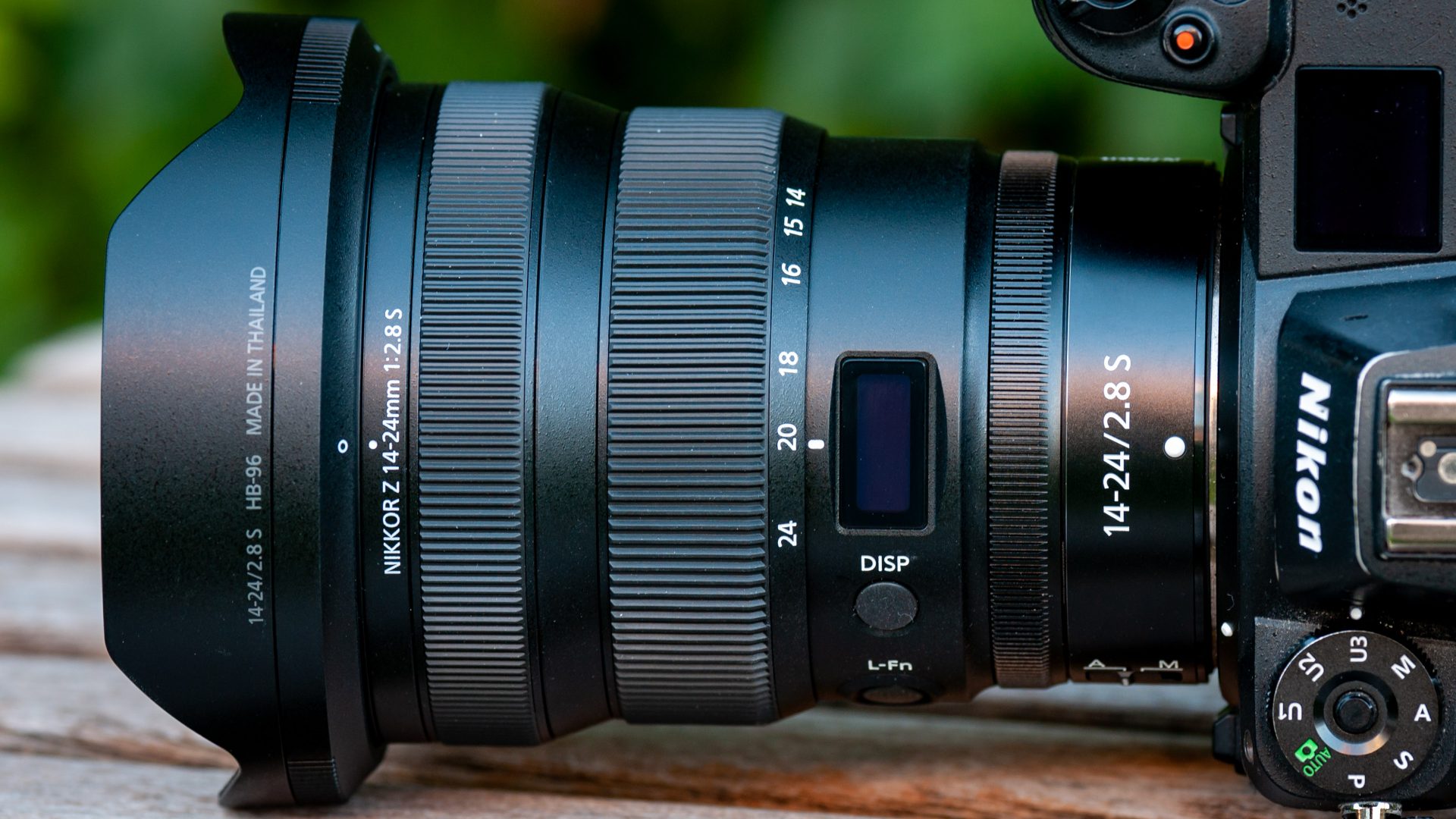
 The Nikon Z 14-24mm f2.8 S clearly is the rightful successor to the legendary Nikon AF-S 14-24mm f2.8G as it is optically better in every aspect than the F-Nikkor except for Bokeh. And with 450g less weight to carry around and a set of nifty features Nikon has managed to create another worthy member for their trinity of professional f2.8 zoom lenses: Highly Recommended!
The Nikon Z 14-24mm f2.8 S clearly is the rightful successor to the legendary Nikon AF-S 14-24mm f2.8G as it is optically better in every aspect than the F-Nikkor except for Bokeh. And with 450g less weight to carry around and a set of nifty features Nikon has managed to create another worthy member for their trinity of professional f2.8 zoom lenses: Highly Recommended!